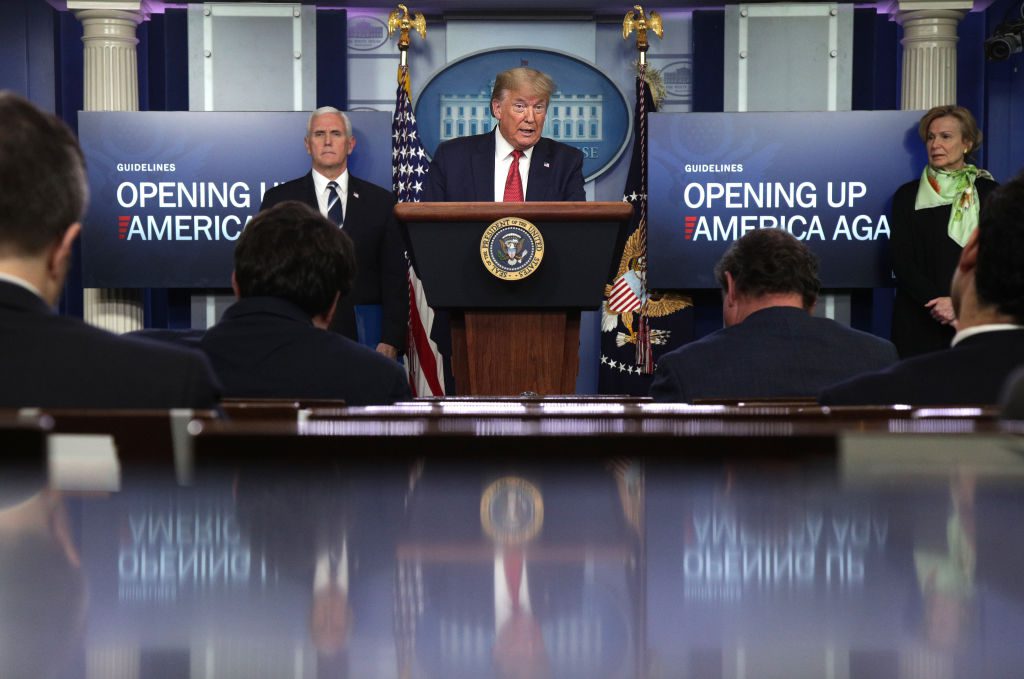Trump’s Plan to Reopen the Economy is the Right One

Like so many of President Trump’s most audacious claims, his bluster that he had “total authority” to re-open the economy was merely an opening bid. The “plan”—really a non-binding set of guidelines—that he and his task force issued yesterday is hardly the stuff of tyranny; it leaves the authority to lift lockdowns in the hands of state governors.
This was no doubt disappointing to a number of prominent conservative commentators who wish to see an immediate re-opening of the economy, broadly. Their focus on the (inevitable) inaccuracy of various epidemiological models has distracted them from the sobering data: nearly 35,000 Americans have died of the coronavirus in the last six weeks, despite the most widespread and aggressive public health measures implemented in this country since 1918. There’s a reason almost every single country in the western world has imposed draconian social distancing: this virus is very contagious, very severe, and, left unchecked, has the potential to break even a very wealthy country’s health care system in short order, as it did in Lombardy.
There are two irreparable defects in the arguments for a broad, universal “re-opening” of the economy. The first is the obvious ethical problem: as Yoram Hazony explained, it’s not clear how Americans could “honor thy father and mother” while flippantly exposing them to a severe disease.
The second defect is the mistaken notion that there is a clear trade-off between public health interventions and the health of the economy. This is flatly wrong: public health interventions do not crush the economy, pandemics do.
During the Spanish Flu, those areas with the most severe outbreaks had the most depressed local economies, and those areas that put in place the most aggressive public health measures saw their economies recover more quickly. The reason is obvious: even in the absence of government diktats, people do not want to go to work, or go out on the town, while a pandemic is spreading uncontrolled. The 81 percent of the public that think social distancing measures need to remain in place aren’t going to turn on a dime and open their wallets until the pandemic is under control.
Those who want a healthy economy should focus on beating the virus.
Given the seriousness of COVID-19, others have suggested that some sort of national lockdown order be put in place. This, too, would be unwise. While New York and New Jersey are still struggling to cope with the epidemic, other states have barely been touched, and are nowhere near exceeding their health care capacity. Shelter-in-place orders are a necessary but temporary measure to protect the health care system. In the more rural parts of America, where health-care systems are not in any jeopardy of being overwhelmed, a phased re-opening is wise. Here, too, the President’s plan is helpful: he suggests that re-opening only occur when the data shows a downward trajectory of relevant illness over a fourteen-day period, with hospitals able to cope, and a robust testing program in place for front-line health care workers.
A staggered plan is best because it will allow hotspots to ride out the crunch while the rest of the country supports those less fortunate areas with goods, services, and a functioning economy.
Moreover, the president’s plan isn’t just epidemiologically sound; it’s politically astute. As a matter of constitutional law, President Trump does not have “total authority” to force states to re-open or remain closed; state-level directives are rooted in the police power, which the federal government does not possess. Showdowns with state governors would leave the president on the legal and political low ground: if the President were to order, say, Gavin Newsom to re-open California, Newsom would have both the power and the political incentive to resist. That would leave the president looking impotent, and Newsom looking like an even more attractive 2024 presidential contender. Conversely, if he were to order the state of North Dakota to stay closed against its governor’s wishes, he would fail, and needlessly agitate his base.
A savvy politician, the president likely grasps this troublesome dynamic and has decided to stay above the fray, issuing guidelines rather than heavy-handed orders. That is the correct move. It’s not time to re-open the entire economy, nor is it time for a heavy-handed, universal federal lockdown. It’s time to beat the virus, in a way that makes sense–and our country’s governors are best positioned to do that.
Will Chamberlain is publisher of Human Events.
Comments